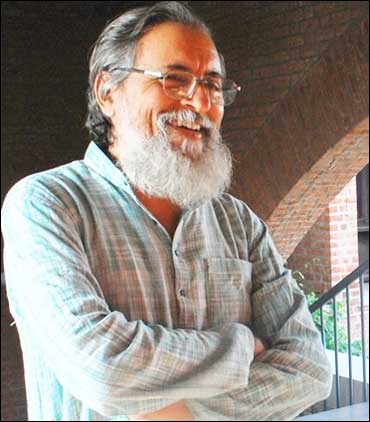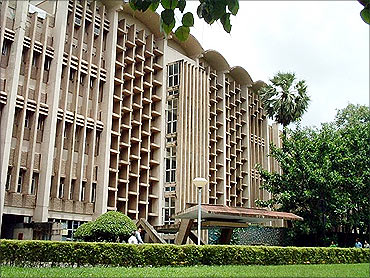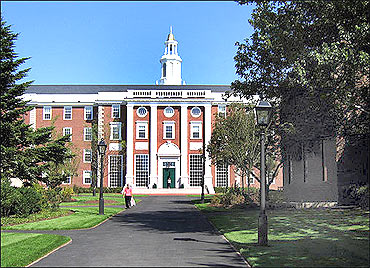
How many of you have wished a change in our education system?
Parul is an intelligent kid. But she dislikes going to school. Everyday she asks her mother, "Why do you send me to school? Why do I have to carry a heavy bag everyday? Why can't I learn everything at home?" And the mother does not have a satisfactory answer.
Amrita, another 8th standard student, religiously studies equations from her chemistry book every night before going to bed. She does it not out of the love for the subject but out of peer pressure to score high marks. And she dreams of a day when she will never have to touch chemistry books
There are thousands of children like them for whom the education system is a burden. "For years, students continue to learn from the same old textbooks, subjects which are of no interest to them. Instead of discovering the potential of kids, and honing their capabilities towards subjects they like, all are forced to study just to score high marks in the examinations," says a teacher who looks forward to a radical change in the education system.
"India, the 1.1-billion people nation, currently has 600 million youth below 25 years of age of which only 320 million are in schools and colleges; less than 25 per cent are employable! The youngest nation on the planet continues to be plagued with a severe job-talent mismatch," says Amit Bhatia, founder and CEO, Aspire India.
The failure of government schools in imparting good education for all and the mushrooming of thousands of incompetent private schools from the primary level to the professional level have tarnished the quality of the education system.
"We have not leveraged the power of education. Our engineers have become people who learn by rote, pass the examination and are incapable of making a difference to the society," Narayana Murthy, Infosys mentor, said on the occasion of Teacher's Day.
And none of the Indian universities figure among the top 100 universities of the world.
So where have we gone wrong?
Click NEXT to read insightful views on India's education system, its pros and cons and how we can improve our education system and creative a productive workforce . . .

We have teachers in this country who kill the spirit of enquiry and creativity in our children. I remember as a student how I was harassed by a teacher who did not like the way I wrote the letter 'f'. Every time he crossed my book, I learnt to defy. Why couldn't he appreciate that I was doing it in a different way?
I got poor marks in English and drawing, just about pass marks in the higher secondary examination while I was reasonably good in Maths and Science. But after I failed to get admission in a university where my father accompanied me, he sort of left me to my fate. He was disappointed that I was not getting admission in any of the colleges he wished. He finally introduced me to one of his colleagues and I had to fend for myself.
If a student is keen on studying a particular topic, the marks he scores in that subject should be taken into consideration when he pursues further studies instead of taking the aggregate marks in all subjects.
There is no scope for original thought in our system. The education system has become a business. So many tuition centres have sprung up. About 60 per cent of the IIM (Indian Institute of Management) students attend some coaching class or the other. So where do the poor stand? It is not that they are not intelligent, they are denied an opportunity. The poor people should also get a chance.
The children with good potential should be given mentoring. They should be given the chance to hone their skills. There is a great need to modernise the education system and bring about inclusive growth.
The Navodaya Schools are a good example of this. They have been successful in giving free residential education to poor students.We need to have a database of inspired teachers. We must record their lessons, share it as open source content through mobile phones and distribute it through educated entrepreneurs across villages.
We also need to build a database of open source educational software, lessons and animation etc., in different languages. It's a shame that despite being called the IT capital of world, the Shristi network had to take a self-supported initiative in this regard.
. . .

Amit Bhatia
Founder & CEO, Aspire Human Capital Management
On India's education system
In India, education, like hockey, has a rich legacy but a challenged present, both in quantity and quality. The good news is that unlike hockey, education is no longer neglected and has great leadership reflecting in the massive legislative reforms in the pipeline -- Right to Education Bill, NCHER Bill, NARAHEI Bill, Educational Tribunal Bill, Foreign Educational Institutions Bill, Universities for Innovation Bill.
The proposed legislative changes are meant to make the $50 billion education market in India ($20 billion on school education, $20 billion on higher education and $10 billion on vocational education, coaching classes, etc) respond to the contemporary requirements. Making an elephant dance or a ship turn is never easy!
India has had a knowledge-based education system for centuries but must quickly embrace skills and employability oriented education. Industrialisation, globalisation and now digitisation have dramatically changed the way the world works and how growing economic and non-economic activities define jobs and careers.
A skills-based education system can catalyse gross enrollment ratios beyond the meagre 12 per cent currently and qualitatively, allow more employable output. Access and capacity must most both be augmented through private and public investments as India needs over 100 universities and 10,000 colleges in the next 5 years.
Moreover, it is no secret that only 25 per cent or less of our graduates and post-graduates are employable. We must embed employability education into all academic streams.
Indian education system too money-oriented?
The Indian education sector, despite a comprehensive overhaul, may not get rid of the 'parallel money economy'. At the heart of the issue is that government has ignored the most important need of the hour -- to allow 'for-profit' education 'officially'.
As a nation, we must shun the hypocrisy on this subject and call a spade a spade! All private education in India is for-profit -- we are not a nation of philanthropists building schools and colleges.
Recognising the need for private investment and the impact of for-profit education in the West and in India (rural/slum schools), the government must allow for-profit education to ensure more transparent corporate-styled education institutions.
In the United States, the largest educators are for-profit companies like Apollo, EDMC, CEC, Devry, Laureate, and ITT. They educate 800,000 students annually in 800 campuses and generate $10 billion in revenues.
These companies have existed on an average for just 40 years. Compared to this the top 6 global universities (Harvard, Cambridge, Yale, Imperial, Oxford, and Princeton) have operated for 400 years on an average, have just 6 campuses and annual educate 100,000 students for $2 billion in fees.
On an average, they cost twice as much as private universities (despite subsidies funded through endowments). Does India not need for-profit education with impact like this? Such institutions will bring professional education at affordable prices to Indian students and help curb the corruption in the Indian education market.
. . .

Amit Bhatia
India in terms of jobs, salaries now
India scores well in jobs and salaries when you look at the top tier institutions like Indian Institutes of Technology (IITs) and Indian Institutes of Management (IIMs). We have 5 million graduates annually and 5 of them also get $100,000 salaries. They usually deserve it! But that's 0.0001 per cent of our graduates.When we get to Tier 2, 3 and 4 institutions, the scene is alarming. Despite the fancy advertisements, most colleges/universities in this category have less than 10 per cent placements for jobs in the range of Rs 8,000-17,000 per month.
At the bottom end, MBAs can earn barely 70 per cent more than uneducated daily wage earners! Is that what an MBA should deliver?
Clearly, these students could get these jobs with vocational or professional education which would cost much less and take less time.
In contrast, the war for talent is pushing salaries in corporate India up at an alarming race 12 per cent CAGR over the last decade. High cost will render Indian service industry uncompetitive over time.
If only we could create more employable MBAs and engineers who can take the higher-paying jobs and stem the high attrition, high salary endemic in Corporate India, we will have a more equitable and progressive nation.
Creating a productive workforce in India
Our education system must immediately embrace skills or employability focus as theoretical knowledge-based education does not help create an employable workforce.
Like many private universities and autonomous colleges are quickly adopting, employability education must be made mandatory in higher education.
We define employability education as non-technical knowledge, skills and attitude requirements which are essential for winning and retaining jobs (e.g., aptitude and problem solving, English language and communication skills, sector and role-based skills like sales or customer service, and, personality/presence and soft skills).
Employability skills are imperative in India as we expect 500 million new job seekers between 2007 and 2022. We must put these people to work to create national wealth, build an equitable society and seize the opportunity of a once-in-a-lifetime demographic dividend.
India, the 1.1 billion people nation, currently has 600 million youth below 25 years of age of which only 320 million are in schools and colleges; less than 25 per cent are employable! The youngest nation on the planet continues to be plagued with a severe job-talent mismatch and needs employability education.
. . .

On India's education system
With such a huge population, getting basic education is a struggle for a large number of Indians. However, for the strata that can afford education, there are multifold options to choose from.
Take the case of B-schools. Till a decade ago, there were a handful of them where even good students used to lose by a hair's breadth. Now, we have over 3,500 schools offering management education. But now the issue of quality comes into play.
There are some who exist with the sole purpose of making money. However, there are some who have long left the legacy educational systems and have architected their curriculum and delivery to meet contemporary requirements.
Also, in India, there is the question of the 'uneven spread' of educational institutes. Therefore, in a small geographical section, we have a preponderance of good institutes whereas in larger parts of the country, even basic educational infrastructure does not exist.
A large part of this due to the fact that the government has limited bandwidth to expand across the country and the private sector is not duly motivated to set up institutes in the interiors of the country.
What is required is for the government to build policy that encourages and rewards private players to setup institutes in a less fettered environment than exists today.
Indian education system too money-oriented?
Historically, capitation fee institutes have existed side by side with good quality institutes. Let's understand that the more capable students get entry to the best-in-class institutes while those who may not be as capable but have money power furnish business for capitation based institutes. Having said that, one cannot generalise to say that the Indian education system as a whole is money-oriented.
In fact, education in India is still perhaps the cheapest across the world. Some institutes have in the recent past become more of job institutes rather than education institutes in the true sense of the word. This is seen more in terms of the ads that the institutes take put with the majority of them stressing more on 100 per cent placement rather than on the quality of placement or the career orientation that the institute provides.
Still, new quality conscious players in the Indian education system have started making a radical shift from just enabling 'jobs' to 'adding value' from day one. The idea is to ensure that the students are so high on the learning curve that the gap in their skills is minimal on joining organisations.
There are a flurry of courses who are bent towards a high degree of 'corporate engagement' and 'global exposure' to ensure maximum productivity of students. This trend is in management as well as technical education.
There is a new powerful role of 'chief curriculum architect' whose sole job is to see that the curriculum is ahead of industry requirements.
. . .

Jagmohan Bhanver
Creating more jobs and build a productive workforce in India
Educational institutes can do this in two ways:
One, helping students develop a CEO mindset by getting them to constantly evaluate new ideas and, two, bringing them to fruition. Therefore, an institute needs to not only impart the attitude of a business-creator but also needs to provide the necessary incubation environment on campus to do so.
Also students need to be made to understand that what has helped nations like the USA is the fact that the best students leave campus to 'create jobs' rather than 'seek jobs'. If we can create a similar culture in India, we will have more jobs being created rather than an environment where there are more job seekers than there are jobs.
A productive workforce can be created by constant updation of new skills, technologies and their applications. The importance of executive development programs cannot be understated here. This is where institutes should focus as much on executive education and management development programmes as they do on regular MBA programmes.
India's score in terms of jobs, salaries now
In the past decade, executives working in India have started getting paid their due, tot he extent that today in most organizations there is a palpably lesser gap between what an Indian executive earns in India as compared to his counterpart in say the US or Europe.
Still, this is limited to a few organizations and limited sectors like IT and banking. Elsewhere, there is still a large gap in earnings of executives in India and overseas developed markets. In terms of the number of jobs however, India perhaps has a greater opportunity than elsewhere, whether it is a comparison with the Middle East or USA or Canada or anywhere else.
In fact, increasingly executives from other more affluent parts of the world have started an exodus back to India given the new found attractiveness & stability that India has as a work place destination.
The challenge for the corporate sector as well as the government now is to make sure that the positive work industry environment persists and at the same time to continue bringing Indian salaries in line with some of the more developed countries.
. . .

Jayashree R
Teacher
As a teacher, I enjoy the experience of educating children to become good citizens. Teachers must be able to identify the strengths of students and and tell them how to develop it.
However, the general feeling among everyone is his/her child should get a good job in a multinational company and be well settled. There is no effort on the part of the parents or teachers to find out what the child is good at and work towards developing his interests.
At many places one would find that the schools do not want to change with the times. They do not like to implement newer and better methods of teaching. I do not know the reason behind this.
The general trend is to go by a fixed set of ideas. I am lucky to have got an opportunity to implement what I have learnt. It gives me great pleasure to teach kids. I observe them very well and try my best to boost their confidence levels.
The education system should focus on an overall development of the personality.
Disadvantages
One of the greatest disadvantages is that our education system is not job-oriented. My schooling in the state board was a disaster as it did not point out my potential. I just did everything because I had to (especially languages like Hindi and Marathi). I often question myself on the value addition.
Existence of many boards spells big money for institutions, but only adds to the confusion of parents and frustration for our children.
Another deterrent is the lack of initiative on the part of teachers. Many of them teach without any passion or interest. Is it fair to let our children be moulded by these pathetic role models?
How can we improve the system?
We can improve the system with a single board throughout the country.
A curriculum to provide for a hands-on experience right from the early years to high school will go along way to help students.
. . .

India's education system
Our schools are just books and marks oriented. Very few life-skills and value-added courses are included in our education system. For example, schools are happy if we IITians approach them to teach mathematics, but much resistant if we work towards children's fitness improvement programs or teach him/her sex education.
Indian education system too money-oriented?
Well, that depends on the institute. Some do not take cash for providing seats to students, and some do. By and large, the goal of education does seem to be generating money rather than imparting/gaining knowledge even at the student level. This has happened as our environment is very competitive.
Parents equate better salary to better education. Times are changing, these days we regularly see young entrepreneurs trying new things rather than catering to existent market.
How to create more jobs and build a productive workforce in India
Currently, most IT/BPO sector employees are serving people in the US/Europe. With off-shore labour laws becoming more stringent in developed countries, India cannot wait till the day they pull out jobs from Indian soil. India has to become self-sustainable in the job market. We need more companies focusing only on serving Indian market.
For better productivity, a college has to do a much better job in imparting education. A recent survey suggested that two thirds of college graduates are unemployable in India.
If a college can charge lakhs as fees students for providing bookish knowledge, I am sure they can provide students training on employability and vocational courses.
. . .

Naresh Gulati
Founder, OCA Group
India's state of education
I believe the Indian education system currently has a big vacuum when it comes to the practical education. The teaching is largely academic in nature and lacks practical touch, which is vital to produce industry-ready graduates. The course curriculum, in most of the courses, is either outdated or lacks futuristic vision.
I do not see any point in teaching courses that would lose its relevance by the time the student passes out of the course. This not only wastes time and money, it also raises false hopes and expectations for the students and families alike.
Indian education system too money-oriented?
There are two types of educational institutions, who need money to teach and the ones who teach to make money. Making money is not a bad thing but not delivering the money's worth is an issue.
In the world that is constantly changing, the institutions are required to make some significant investments on an ongoing basis. This certainly requires the institutions to make some profits but they need to make sure they deliver for what they charge and that too with a noble vision.
Building productive workforce in India
We need to have education system that lays strong focus on practical aspects of education. For example, there could be a work placement year in most of the professional degrees like in the western world.
The education system must lay strong emphasis on topics such as leadership that would educate and empower the students with self-initiating skills.
Another aspect could be developed around the fact that a 'healthy mind means better productivity'.
Our education system lacks mental training. Human education aspects such as meditation and coaching on how to live a stress free life can help the graduates handle stress in their lives in a much more effective way. All this would certainly increase their productivity.India in terms of jobs, salaries now
India has just starting walking on the growth path. We are likely to see significant increase in demand of quality professionals across the industry. But given the current education system, the graduates' skills may not be able to manage this demand especially in middle to top management level.
This may require us to import manpower from developed countries if the education system does not change to address the future needs.
. . .

India's state of education
India from the very beginning has been considered as an important centre of learning and education. We were the ones to have created the first global university, the Takshila. However, over a period of time, foreign universities have taken the reign. Since our roots are very strong, we need to realign with the changed requirements.
Many foreign students are coming to India for studying, but the higher education is still at the evolution stage and a good foundation needs to be built. One of the advantages is that students still respect the teachers and look up to them as knowledge providers. However, we need to go a long way to match the industry standards.
Indian education system too money oriented?
It would be wrong to say that education system has a money oriented approach. In fact, the fee structure is most economical when compared with the rest of the world. As the government grants are moving out, there is actually a requirement to revise the fee structure. At present, there is a conflict about courses being jobs oriented or not. The Indian economy needs people who have correct job skills with the right education.
How to build a productive workforce in India
The Indian economy is growing at a faster rate than the most economies and it is expected that more jobs would be created over a period of time.
The universities need to understand the requirement of students and work closely with the industry to create a good workforce.
India in terms of jobs, salaries now
Even during the recession, we are amongst the few countries which did not bear the brunt of job losses. With a fast paced growth, organisations are looking at competitive manpower and are ready to offer salaries higher than ever before.